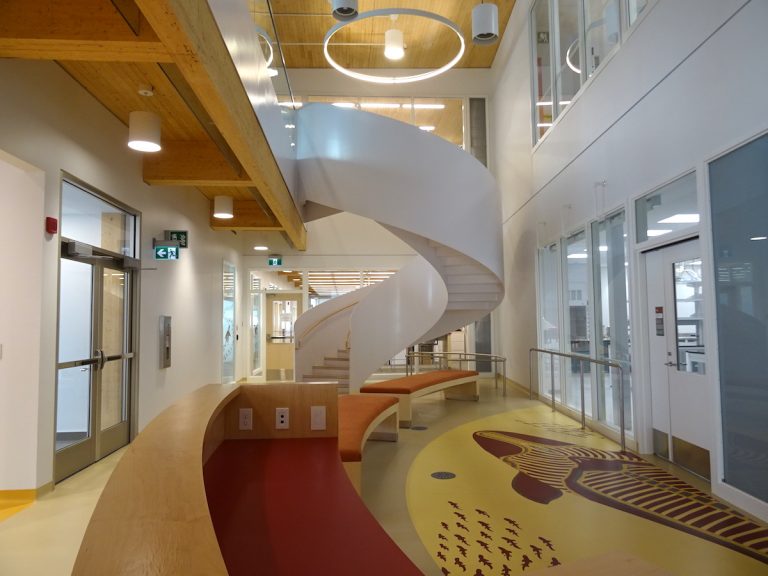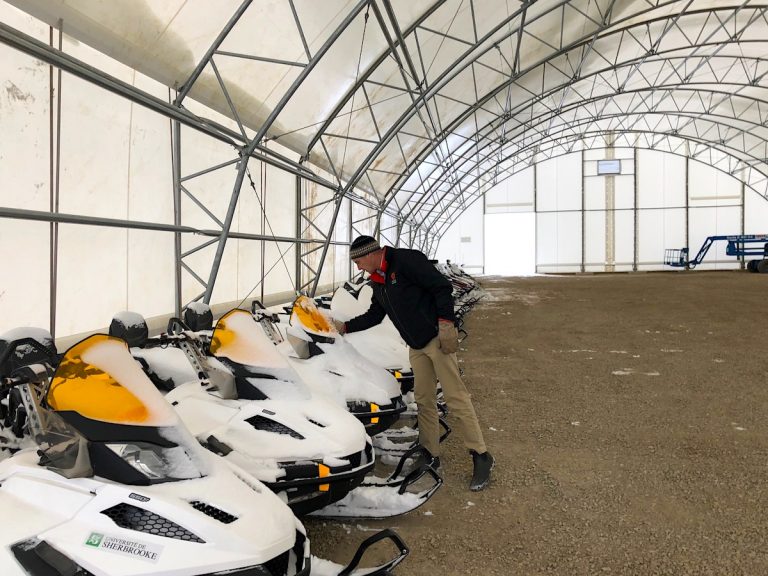Canada’s new Arctic research facility remains mysterious to some of its neighbors
Here's some of the research connected with the CHARS facility in Cambridge Bay.
CAMBRIDGE BAY — The Canadian High Arctic Research Station in Cambridge Bay, which officially opened in August, is big and beautiful, but remains a mystery to many in this western Nunavut hub.
Inside the facility, CHARS scientists are investigating animal life and climate change, and they say they work with the local hunters and draw on traditional knowledge.
But a lot of this has stayed within the walls of the main science building at CHARS.
As winter closes in, the copper-colored building sits like a large pumpkin outside town: Its decorative stripes are lit up like northern lights, while the lights remain on inside CHARS, where you can catch eerie glimpses of large carvings inside.
Behind the main building at CHARS, there’s a large new 200-by-90-foot white fabric structure. It sprang up at the end of summer, and in Cambridge Bay, any new structure of that size attracts notice.
On a visit to CHARS last week with David Scott, the CEO and president of Polar Knowledge Canada, the federal agency which oversees the facility, Scott revealed what’s inside the white structure: no “Area 51” there, he joked. Inside, you see just a long line of snowmobiles and other equipment.
Some have speculated, fueled by this past summer’s recent military exercise, that Cambridge Bay, along with CHARS, is slated to be the future site of a new northern operating hub for the armed forces.
Asked about that, Scott scrunched up his forehead in puzzlement. He said CHARS does work with the military on some of its science and technology projects, but nothing more.
To change CHARS’ vocation would require a change in the 2015 CHARS Act, Scott said.
The only new role envisioned for CHARS could be as an emergency refuge for residents of Cambridge Bay, because the facility has its own generator to provide light and heat, Scott said.
The lack of knowledge among people in Cambridge Bay about what goes on at CHARS may be linked to its lack of staff.
Scott, based in Ottawa himself, hadn’t been there since the Aug. 22 CHARS opening.
Polar Knowledge Canada currently has 26 staff in Cambridge Bay, 39 staff in Ottawa and three staff in other locations. About a third are Inuit.
There’s been a lot of recent turnover at CHARS, too: Chief Scientist Martin Raillard left in September.
Other CHARS staff members have also left, although Scott said this kind of mobility is natural within the federal civil service.
The main science building, with its array of art from Inuit Nunangat, and oversized spaces, seems generally empty, spotless and silent, unlike other buildings in Cambridge Bay, which tend to be dusty and overcrowded.
Two Kitikmeot Chamber of Commerce employees occasionally occupy desks outside the locked CHARS office space, but otherwise everything is quiet.
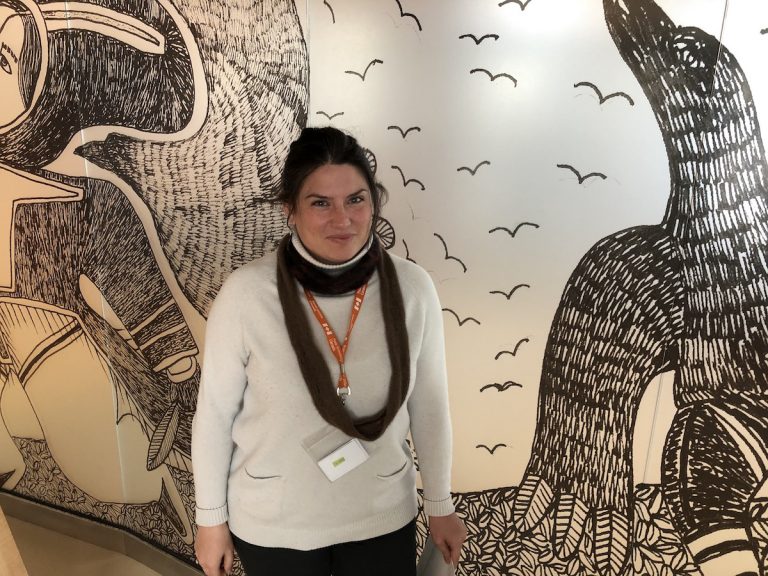
Nunatsiaq News did manage to meet with three CHARS researchers who live and work in Cambridge Bay.
Two of these researchers at CHARS, well-regarded in their field of study, are not widely known in Cambridge Bay.
But that’s not the case with muskox researcher Matilde Tomaselli, who had been coming to Cambridge Bay regularly since 2013 and is now the CHARS’ wildlife researcher.
Muskox research relies on hunters
Tomaselli, a doctor of veterinary science from the University of Guelph, first came to Cambridge Bay to look at the health and population of muskox — an “amazing animal,” she said — because their numbers were in decline and no one knew why.
Her major research collaborator is the Ekaluktutiak Hunters and Trappers Organization, which hands out kits so hunters can sample muskox for health indicators.
Analysis of these samples — not carried out at CHARS — have detected brucellosis and other diseases affecting muskox.
Working with the HTO has shown the importance of collecting knowledge from Inuit harvesters for continuous monitoring of a wildlife population, Tomaselli said.
This team model could also be used to monitor other wildlife, she said, because it showcases how you can bridge science and traditional knowledge and collaborate “to supply an early warning on what is happening.”
NASA takes a big-picture view on climate change
While Tomaselli works on the ground, the project of another CHARS researcher, Adam Houben, stretches from the ground to the sky.
He’s the Canadian point of contact for NASA’s Arctic-Boreal Vulnerability Experiment, also known as ABoVE, whose specially-equipped aircraft criss-crossed the skies above Cambridge Bay for several days in early August.
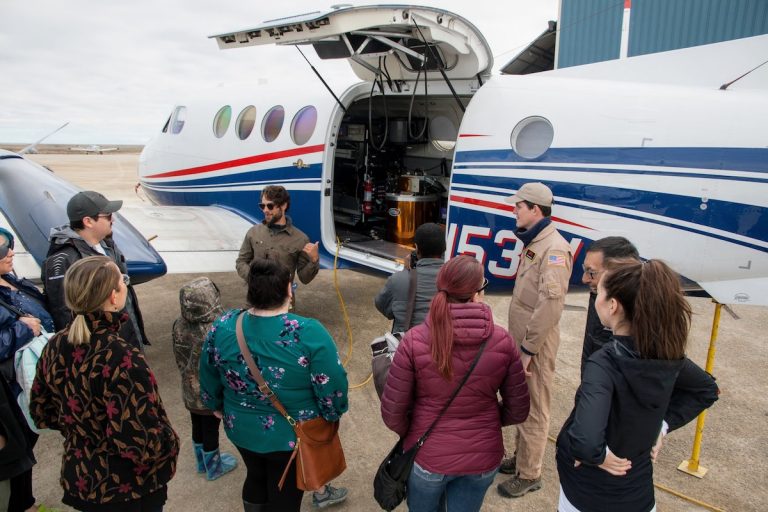
It pulled a crowd of local residents from Cambridge Bay who came to the airport to see the King Air B-200 turboprop aircraft loaded with special sensors.
There’s nothing like NASA to draw a crowd, said Houben, who also serves as a science officer for Polar Knowledge Canada.
That airborne survey is just a small part of a 10-year program that started in 2017 and involves more than 100 separate projects and 700 researchers.
In short, ABoVE aims to see the overall terrestrial response to climate change on a “huge landscape scale,” he said.
Looking at the springtail for clues to the future
For a more up-close view of what CHARS research looks like, there’s Ian Hogg, the team leader for ecosystem science at CHARS.
A Canadian by birth, Ian Hogg previously lived in New Zealand, where he often worked out of Antarctica.
His research in Cambridge Bay combines down-to-earth work to find bugs with high-tech barcoding, a tracking method of species identification using a short section of DNA.
And his favourite species is the springtail, a tiny, multi-legged insect, which he describes as a”primitive insect-like” thing.
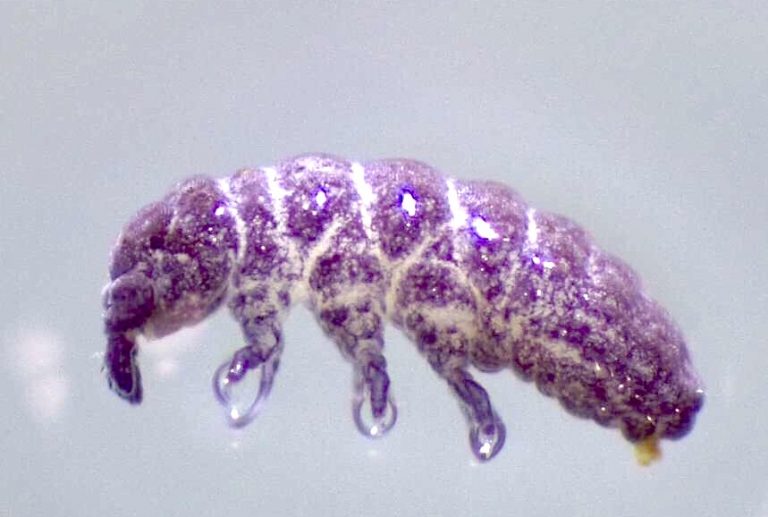
Springtails are interesting because in winter they create antifreeze. The idea is to see what they are doing at different times of year, he said.
During the summer, he and his team track springtails — this past summer their outreach included taking local children around CHARS for a springtail-search.
“If you want to find a springtail, you have to go under rocks,” he said.
Hogg’s research hopes to see what happens as the climate changes. With the introduction of new species, the springtail might just get completely wiped out, he said.
The project includes putting probes into lichens, those orange splotches commonly seen on rocks around the High Arctic.
Despite the cold temperatures and low light, apparently they’re still active now, Hogg said.
With his research, Hogg said he hopes to create “a baseline of all the animals that are here so eventually we can see how these change over time.”
Hogg said the aim for CHARS is to develop the center into a more populated, year-round research facility like you find in southern universities.
“We would like it so students don’t [just] come in the summer, so they do have a year-round presence,” he said.
But there’s a price to developing this kind of research in the High Arctic: announced by Prime Minister Stephen Harper in 2012, CHARS cost an initial $142.4 million to build and a further $46.2 million to complete, and now costs about $7.1 million a year to operate, which is rolled into Polar Knowledge’s budget of about $29 million.


